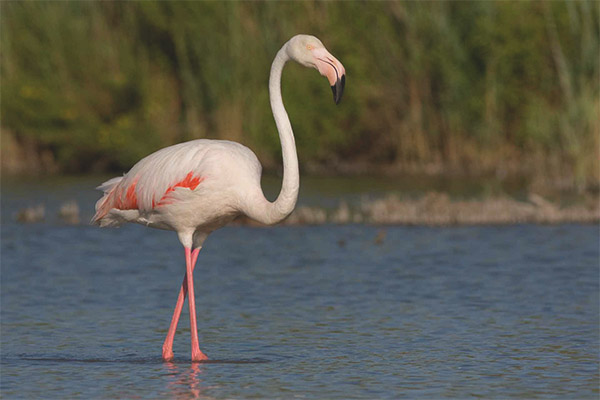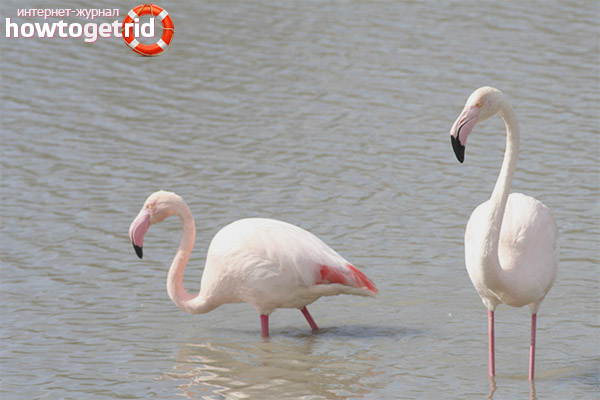The content of the article
Common flamingo is a rather popular bird from the order of flamingos. The second name of these individuals is pink flamingo. It is not just that this species is known almost by everyone; the pink flamingo is the most common, and at the same time, a large variety. These birds are created by very beautiful, unique and elegant individuals. Below we present a detailed description of the pink flamingo, as well as some interesting facts about these birds.
Flamingo appearance
The appearance of these pink birds is not able to go unnoticed. These individuals are rewarded by nature with thin and long legs, as well as with a long and very flexible neck. The color of the flamingo is very unusual and attracts many views. In adults, the plumage often has a pale pinkish hue. The wings of these birds have a purple-red hue, with the exception of a few flight wings, which are painted black. The long legs of these individuals also stand out pinkish.The beak is painted in a similar shade, only its tip is different and has a black color.
The unusual appearance of a flamingo consists not only of a beautiful color, but also of a long and graceful neck, which is very elegantly presented in the form of a question mark. Often they attract the attention of others when they are standing on one leg. They do this in order to save heat, hiding one leg in their plumage. When you look from the side, it seems that this position is extremely inconvenient, however, for flamingos, this position is very simple and does not require any additional effort.
On the head of these pink birds, a very massive bill is noticeably prominent. In comparison with most relatives, the flamingo is the upper region of the beak can change position, but the lower one, on the contrary, is in a static state. Also on the head of these birds you can see areas free from feathers, which are painted in bright red. These include the bridle and the area around the eyes. The body of the flamingo is rather rounded, and the tail is short.
Outwardly, they seem quite large. This is due primarily to their considerable length. Adults reach a length of 130 centimeters.The body weight of birds in this case is up to 4 kilograms. On the legs, 4 fingers can be distinguished, and 3 of them will be connected by a special swimming membrane.
Many wonder why flamingos are so unusual for birds - pink. The fact is that this shade gives them a certain substance - carotene, which enters their body along with food. More carotene is found in small red crustaceans, which are used in large quantities by flamingos. It is to them that the birds owe their beautiful unusual color.
While living in a zoo, flamingos also retain their color, as products containing carotene are introduced into their diet. These include carrots, small crustaceans, and sweet peppers. It is thanks to these components that the flamingos in the zoo remain as bright and beautiful as in nature.
Habitat and lifestyle
Pink or common flamingo is the most common type of flamingo. These birds live in the territories of Europe, mainly from the south, in Africa, as well as in south-west Asia.In the European part of the areola flamingos can be found in Sardinia, France, as well as Spain. On the African continent, flamingos are found in its southern territories. Moreover, these individuals are common in Tunisia, on the island part of Cape Verde, in Morocco, Kenya and Mauritania. You can also notice strolling flamingos on the island of Sri Lanka, in the lakes of southern Afghanistan and in the north-west of India. Surprisingly, these birds can also be found in parts of Kazakhstan's water bodies.
On the territory of our country, pink flamingos do not build nests, however, they migrate every year across the territory of the mouth of the Volga River, the Stavropol Territory and the Krasnodar region. Sometimes these individuals fly even to Siberia, the Urals, Yakutia and Primorsky Krai. In Russia, they do not live, but only fly past its territories. Flamingos are experiencing winter in the territories of Azerbaijan, Iran and Turkmenistan.
Flamingos are collective birds, they do not live alone. You can meet them in the most diverse groups. When birds fly from one place to another, they join together in fairly large flocks. During the nesting period, they are kept in small groups.Flamingos are located mainly on lakes with a high salt content in the water, as well as in estuaries and marine lagoons. You can meet them in places that do not have open access and include a muddy bottom of the reservoir. These birds live along the shores of large lakes and other water bodies. Here you can see whole colonies of flamingos, their number can reach several hundred thousand individuals.
In most cases, flamingos are extremely sedentary, however, from time to time they are able to move within their areola if they find places with more comfortable conditions. Sometimes the reason for the move is an insufficient amount of food in the former place of residence. Those populations that live in the north, make flights to warmer areas for nesting.
Flamingos are hardy birds that are able to live in completely different conditions. They easily tolerate temperature fluctuations, they are also able to survive even extreme weather conditions. They are found near very saline and alkaline reservoirs. This is primarily due to the fact that a large number of crustaceans live in such lakes.The fish here, as a rule, is absent, because it cannot live in such salty water. Mostly flamingo ordinary lives on lakes high in the mountains.
Due to the active work of business executives, as well as poachers, the number of colonies of flamingos was significantly reduced. Today in the Red Book this species is listed as not causing concern.
Flamingo diet
The basis of the diet of flamingo ordinary are crustaceans. In addition to them, they can be used to eat various insects, worms, clams, and even algae. The unusual and large beak helps them to get food for these birds, with which it can easily separate food from water and sludge. First, the bird collects water in its beak, after which it closes it and begins to gradually push the water out, leaving food in the mouth. This process is very fast.
The only danger to flamingos are predators, which often settle near their colonies. If individuals feel the danger and anxiety, they scatter and take off. Interestingly, equally successful flamingos can scatter both on the water and on the ground.
Video: common flamingo (phoenicopterus roseus)












To send